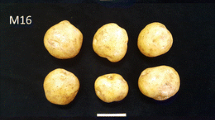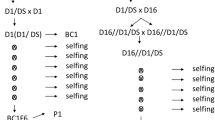Abstract
Resistance to common scab continues to be a high priority trait for potato breeders. We have identified a source of resistance in the diploid wild potato relative Solanum chacoense and have introgressed it into cultivated potato by crossing it to a dihaploid. A clone generated by crossing two full-sib hybrids is highly resistant and produces both 2n pollen and 2n eggs. This clone, named 4–48, is homozygous for a major QTL for scab resistance derived from S. chacoense. Clone 4–48 was reciprocally crossed to three round white cultivars Megachip, Pike, and White Pearl. Common scab resistance was transferred to tetraploid offspring, with transmission through the male parent generally more effective than through the female parent. The majority of progeny (70%) exhibited stability for resistance to common scab across environments. This germplasm will be useful for breeding new resistant cultivars.
Resumen
La resistencia a la roña común continúa siendo un carácter de alta prioridad para los mejoradores de papa. Hemos identificado una fuente de resistencia en la papa silvestre diploide Solanum chacoense, y la hemos incorporado a la papa cultivada mediante cruzamiento con un dihaploide. Un clon generado mediante la cruza de dos híbridos hermanos completos de progenie es altamente resistente y produce polen 2n y huevos 2n. Este clon, llamado 4–48, es homocigótico para un QTL mayor para resistencia a la roña derivado de S. chacoense. El clon 4–48 se cruzó recíprocamente a tres variedades redondas blancas, Megachip, Pike, y White Pearl. La resistencia a la roña común se transfirió a la descendencia tetraploide, con transmisión a través del padre, generalmente más efectivo que a través de la madre. La mayoría de la progenie (70%) exhibió estabilidad para la resistencia a la roña común a lo largo de los ambientes. Este germoplasma será útil para el mejoramiento de nuevas variedades resistentes.
Similar content being viewed by others
References
Alam, Z. 1972. Inheritance of scab resistance in 24-chromosome potatoes. Ph.D. University of Wisconsin-Madison. 58 pp.
Archuleta, J., and G. Easton. 1981. The cause of deep-pitted scab of potatoes. American Potato Journal 58: 385–392.
Bjor, T., and L. Roer. 1980. Testing the resistance of potato varieties to common scab. Potato Research 23: 33–47.
Braun, S. 2013. Quantitative trait loci analysis and breeding for resistance to common scab in potato. Ph.D. Thesis University of Wisconsin-Madison. 125 pp.
Braun, S., J. Endelman, K. Haynes, and S. Jansky. 2017. Quantitative trait loci for resistance to common scab and cold-induced sweetening in diploid potato. The Plant Genome. In press.
Camadro, E., and S.J. Peloquin. 1980. Polyploid evolution of wild potatoes via genetically determined 2n gametes. American Potato Journal 57: 473.
Capo, A., M. Cammareri, F. Della Rocca, A. Errico, A. Zoina, and C. Conicella. 2002. Evaluation for chipping and tuber soft rot (Erwinia carotovora) resistance in potato clones from unilateral sexual polyploidization (2x x 4x). American Journal of Potato Research 79: 139–145.
DenNijs, T.P.M., and S.J. Peloquin. 1977a. Polyploid evolution via 2n gametes. American Potato Journal 54: 377–386.
DenNijs, T.P.M., and S.J. Peloquin. 1977b. 2n gametes in potato species and their function in sexual polyploidization. Euphytica 26: 585–600.
Dionne, L.A., and C.H. Lawrence. 1961. Early scab resistant derivatives of Solanum chacoense x Solanum phureja. American Potato Journal 38: 6–8.
Douches, D.S., and R. Freyre. 1994. Identification of genetic factors influencing chip color in diploid potatoes (Solanum spp.). The. American Potato Journal 71: 581–590.
Driscoll, J., J. Coombs, R. Hammerschmidt, W. Kirk, L. Wanner, and D. Douches. 2009. Greenhouse and field nursery evaluation for potato common scab tolerance in a tetraploid population. American Journal of Potato Research 86: 96–101.
Frost, K.E., S.H. Jansky, and D.I. Rouse. 2006. Transmission of Verticillium wilt resistance to tetraploid potato via unilateral sexual polyploidization. Euphytica 149: 281–287.
Goth, R., H. KG, and D. Wilson. 1993. Evaluation and characterization of advanced potato breeding clones for resistance to scab by cluster analysis. Plant Disease 77: 911–914.
Grun, P. 1970. Cytoplasmic sterilities that separate the cultivated potato from its putative diploid ancestors. Evolution 24: 750–758.
Grun, P., and M. Aubertin. 1966. Cytological expression of a cytoplasmic male sterility in Solanum. American Journal of Botany 53: 295–301.
Hamernik, A.J., R.E.J. Hanneman, and S.H. Jansky. 2009. Introgression of wild species germplasm with extreme resistance to cold sweetening into the cultivated potato. Crop Science 49: 529–542.
Hanneman, R.E., and S.J. Peloquin. 1968. Ploidy levels of progeny from diploid-tetraploid crosses in the potato. American Potato Journal 45: 255–261.
Hanneman, R.E., and S.J. Peloquin. 1981. Genetic-cytoplasmic male sterility in progeny of 4x-2x crosses in cultivated potatoes. Theoretical and Applied Genetics 59: 53–55.
Haynes, K.G. 1990. Covariances between diploid parent and tetraploid offspring in tetraploid x diploid crosses of Solanum tuberosum L. Journal of Heredity 81: 208–210.
Haynes, K.G. 1992. Covariance between haploid-species hybrid and Tuberosum x haploid-species hybrid in 4x x 2x crosses of Solanum tuberosum L. Journal of Heredity 83: 119–122.
Haynes, K., L. Wanner, C. Thill, J. Bradeen, J. Miller, R. Novy, J. Whitworth, D. Corsini, and B. Vinyard. 2010. Common scab trials of potato varieties and advanced selections at three U.S. locations. American Journal of Potato Research 87: 261–276.
Hosaka, K., H. Matsunaga, and K. Senda. 2000. Evaluation of several wild tuber-bearing Solanum species for scab resistance. American Journal of Potato Research 77: 41–45.
Iwanaga, M., P. Jutala, R. Ortiz, and E. Guevara. 1989. Use of FDR 2n pollen to transfer resistance to root knot nematodes into cultivated 4x potatoes. Journal of the American Society of Horticultural Science 114: 1008–1013.
Jansky, S., D. Douches, and K. Haynes. 2017. Germplasm release: Three tetraploid potato clones with resistance to common scab. American Journal of Potato Research. Submitted.
Johnston, S.A., and R.E. Hanneman. 1982. Manipulations of endosperm balance number overcome crossing barriers between diploid Solanum species. Science 217: 446–448.
Kang, M.S. 1989. A new SAS program for calculating stability-variance parameters. Journal of Heredity. 80: 415.
Knapp, S.J., W.W. Stroup, and W.M. Ross. 1985. Exact confidence intervals for heritability on a progeny mean basis. Crop Science 25: 192–194.
Köhler, C., P. Wolff, and C. Spillane. 2012. Epigenetic mechanisms underlying genomic imprinting in plants. Annual Review of Plant Biology 63: 331–352.
Lambert, D., A. Reeves, R. Goth, G. Grounds, and E. Giggie. 2006. Relative susceptibility of potato varieties to Streptomyces scabiei and S. acidiscabies. American Journal of Potato Research 83: 67–70.
Loria, R. 2001. Common scab. In Compendium of potato diseases, ed. W.R. Stevenson, R. Loria, G.D. Franc, and D.P. Weingartner, 2nd ed., 14–15. St. Paul: The American Phytopathological Society.
Maris, M. 1989. Analysis of an incomplete diallel cross among three ssp. tuberosum varieties and seven long-day adapted ssp. andigena clones of the potato (Solanum tuberosum L.). Euphytica 41: 163–182.
Marks, G.E. 1966. The enigma of triploid potatoes. Euphytica 15: 285–296.
McCann, L.C., P.C. Bethke, and P.W. Simon. 2010. Extensive variation in fried chip color and tuber composition in cold-stored tubers of wild potato (Solanum) germplasm. Journal of Agricultural and Food Chemistry 58: 2368–2376.
Mendiburu, A.O., and S.J. Peloquin. 1977. The significance of 2n gametes in potato breeding. Theoretical and Applied Genetics 49: 53–61.
Murphy, A.M., H. De Jong, and G.C.C. Tai. 1995. Transmission of resistance to common scab from the diploid to the tetraploid level via 4x-2x crosses in potatoes. Euphytica 82: 227–233.
Plaisted, R.L., D.E. Halseth, B.B. Brodie, S.A. Slack, J.B. Sieczka, B.J. Christ, K.M. Paddock, and M.W. Peck. 1998. Pike: A full season scab and golden nematode resistant chipstock variety. American Journal of Potato Research 75: 117–120.
Quinn, A.A., D.W.S. Mok, and S.J. Peloquin. 1974. Distribution and significance of diplandroids among the diploid solanums. American Potato Journal 51: 16–21.
Sanetomo, R., and C. Gebhardt. 2015. Cytoplasmic genome types of European potatoes and their effects on complex agronomic traits. BMC Plant Biology 15: 162.
Sanford, J., and R. Hanneman. 1982. Large yield differences between reciprocal families of Solanum Tuberosum. Euphytica 31: 1–12.
Spooner, D.M., M. Ghislain, R. Simon, S.H. Jansky, and T. Gavrilenko. 2014. Systematics, diversity, genetics, and evolution of wild and cultivated potatoes. The Botanical Review 80: 283–383.
Tegg, R., and C. Wilson. 2010. Relationship of resistance to common scab disease and tolerance to thaxtomin a toxicity within potato cultivars. European Journal of Plant Pathology 128: 143–148.
Wanner, L.A. 2009. A patchwork of Streptomyces species isolated from potato common scab lesions in North America. American Journal of Potato Research. 86: 247–264.
Wanner, L.A., and K.G. Haynes. 2009. Aggressiveness of Streptomyces on four potato cultivars and implications for common scab resistance breeding. American Journal of Potato Research 86: 335–346.
Weber, B.N., A.J. Hamernik, and S.H. Jansky. 2012. Hybridization barriers between Solanum tuberosum and wild Solanum raphanifolium. Genetic Resources and Crop Evolution 59: 1287–1293.
Werner, J.E., and S.J. Peloquin. 1991. Occurrence and mechanisms of 2n egg formation in 2x potato. Genome 4: 975–982.
Zorrilla, C., F. Navarro, S. Vega, J. Bamberg, and J. Palta. 2014. Identification and selection for tuber calcium, internal quality and pitted scab in segregating “Atlantic” x “superior” reciprocal tetraploid populations. American Journal of Potato Research 91: 673–687.
Author information
Authors and Affiliations
Corresponding author
Rights and permissions
About this article
Cite this article
Jansky, S., Douches, D. & Haynes, K. Transmission of Scab Resistance to Tetraploid Potato Via Unilateral Sexual Polyploidization. Am. J. Potato Res. 95, 272–277 (2018). https://doi.org/10.1007/s12230-017-9628-7
Published:
Issue Date:
DOI: https://doi.org/10.1007/s12230-017-9628-7




